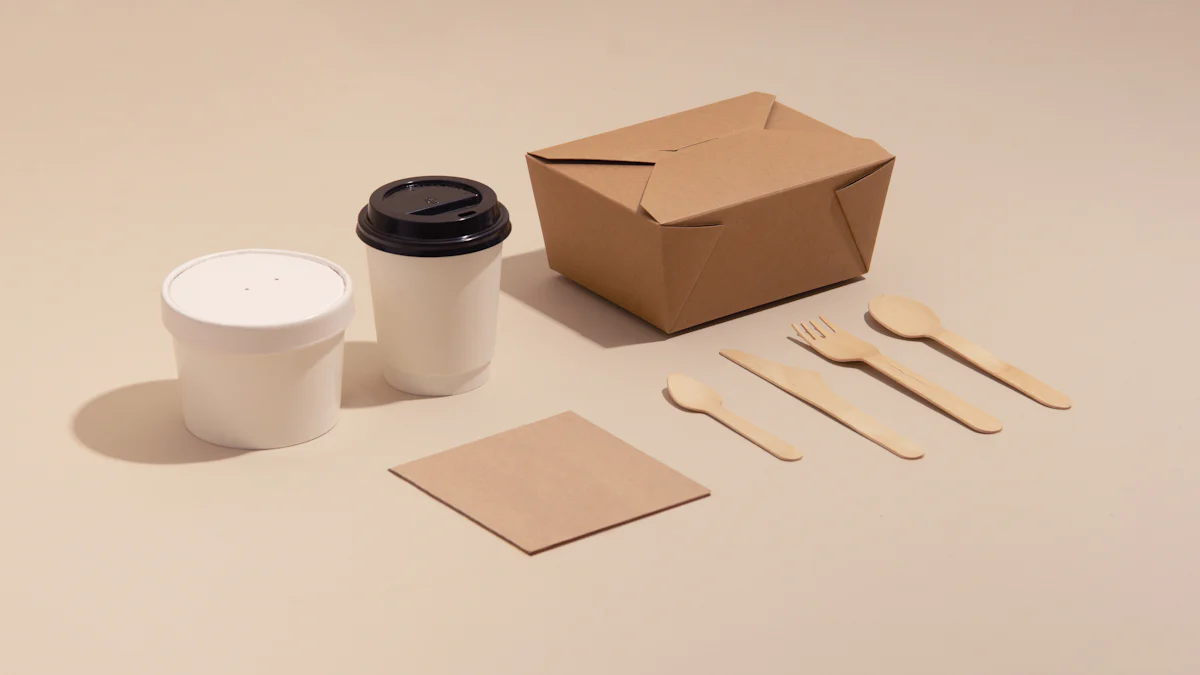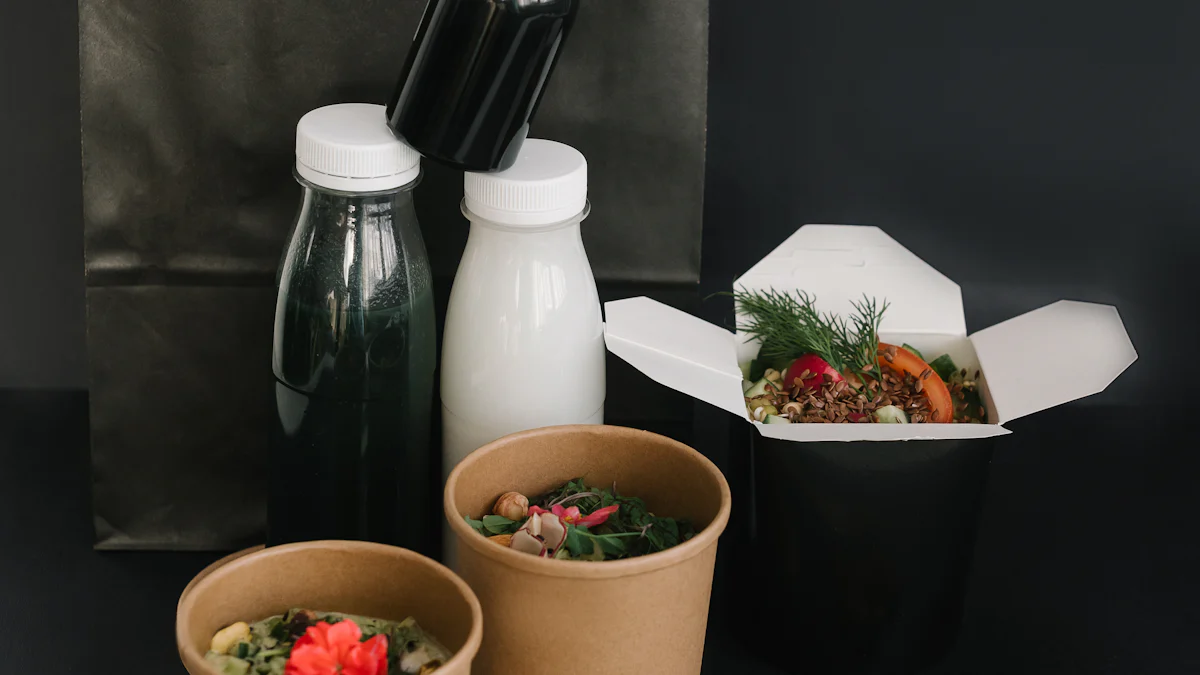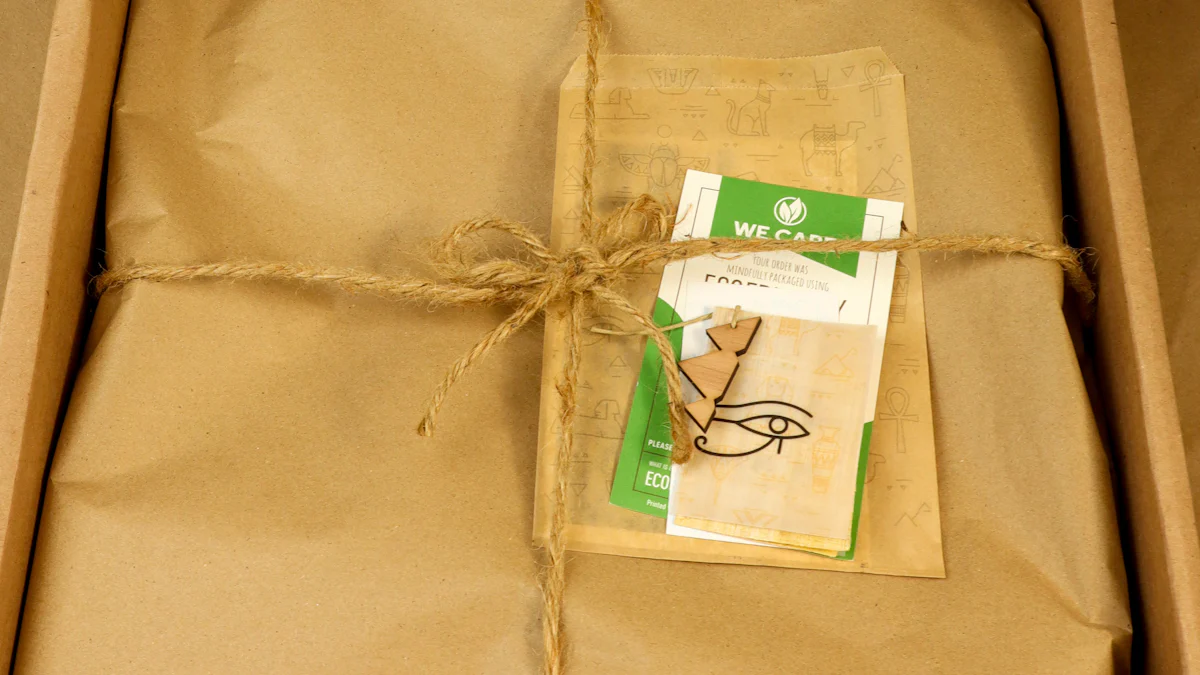
Sustainable packaging has become a priority for businesses aiming to reduce their environmental footprint. Biodegradable containers, including the 5 compartment biodegradable container, play a crucial role in this shift by offering eco-friendly alternatives to traditional plastics. Unlike conventional packaging, these containers rely on renewable resources like corn stover and require less energy during production. They decompose into harmless compounds, supporting a carbon-neutral cycle.
Choosing the right biodegradable container with lid supplier ensures quality and aligns with corporate sustainability goals. Companies like Unilever and Nestlé have committed to making all packaging biodegradable or recyclable by 2025. This trend highlights the growing importance of eco-conscious practices in enhancing brand reputation and meeting consumer expectations.
Key Takeaways
- Biodegradable containers break down naturally, cutting plastic waste and helping the planet.
- Picking a good supplier gives you quality containers that match your business’s green goals.
- Using eco-friendly packaging improves your brand image and draws in eco-friendly customers.
Understanding Biodegradable Containers
What Are Biodegradable Containers?
Biodegradable containers are eco-friendly alternatives to traditional plastic packaging. These containers decompose naturally into harmless compounds, leaving no toxic residue behind. Manufacturers use renewable materials to create them, ensuring sustainability. Common materials include:
- Cornstarch: A versatile material derived from corn, often used for molded shapes and loose-film packaging.
- PLA (Polylactic Acid): A plant-based plastic made from renewable resources like corn starch.
- Sugarcane Bagasse: The fibrous residue left after extracting juice from sugarcane.
- Bamboo: A fast-growing, sustainable material gaining popularity in eco-friendly packaging.
- Paper and Cardboard: Fully biodegradable and widely used for takeaway containers.
These materials make biodegradable containers a practical choice for businesses aiming to reduce their environmental impact.
Key Benefits of Using Biodegradable Containers
Switching to biodegradable containers offers several environmental and business advantages:
- They reduce plastic pollution by decomposing naturally, unlike traditional plastics that persist in landfills.
- Their production requires less energy, resulting in a lower carbon footprint.
- They protect marine life by breaking down in aquatic environments without harming wildlife.
By adopting these containers, businesses can align with sustainability goals while enhancing their brand reputation.
Why Lids Are Essential for Sustainable Packaging
Lids play a crucial role in sustainable packaging. They ensure the contents remain secure, preventing leaks and contamination. For businesses in the food and beverage industry, lids maintain freshness and temperature control. When paired with biodegradable containers, lids made from materials like PLA or bagasse complete the eco-friendly packaging solution. Choosing the right biodegradable container with lid supplier ensures high-quality products that meet both functional and environmental needs.
Types of Biodegradable Containers with Lids

Bagasse Containers: Pros and Cons
Bagasse containers are made from sugarcane residue, a by-product of sugar production. These containers are microwave-safe and durable, making them ideal for hot and cold foods. They are compostable, breaking down into fertilizer that enriches the soil. Businesses in the food industry often prefer bagasse for its eco-friendly properties and ability to handle greasy or wet foods. However, bagasse containers may not be suitable for long-term storage due to their natural decomposition process.
PLA (Polylactic Acid) Containers: Pros and Cons
PLA containers are crafted from renewable resources like corn starch. They emit fewer greenhouse gases during production, boasting a 75% lower carbon footprint compared to traditional plastics. These containers are lightweight and transparent, making them perfect for showcasing food items. While PLA containers are more expensive than conventional plastics, they appeal to environmentally conscious consumers. Businesses must ensure proper disposal methods, as PLA requires industrial composting facilities to degrade effectively.
Bamboo Containers: Pros and Cons
Bamboo containers are gaining popularity due to their sustainability. Bamboo grows quickly and regenerates without replanting, making it an excellent renewable resource. These containers are sturdy, biodegradable, and naturally resistant to bacteria. They are ideal for premium packaging, adding a touch of elegance to your brand. However, bamboo containers may have a higher upfront cost, which businesses should consider when budgeting.
Starch-Based Bioplastics: Features and Applications
Starch-based bioplastics combine plant starch with compostable plastics, enhancing their strength and water resistance. These materials are used in trays, cups, and plates. Advanced versions include antimicrobial packaging, which extends shelf life and prevents microbial growth. Starch-based films reinforced with natural fibers like wheat hulls improve durability and reduce water vapor permeability. These features make starch-based bioplastics versatile for food, industrial, and medical packaging.
Paperboard and Cornstarch Containers: When to Use Them
Paperboard and cornstarch containers are versatile and widely used for takeaway packaging. Paperboard is renewable, recyclable, and suitable for dry foods. Cornstarch containers, on the other hand, are compostable and ideal for wet or greasy foods. Both options are lightweight and customizable, making them excellent for branding. Businesses in the food and retail industries often choose these containers for their affordability and eco-friendly appeal.
Factors to Consider When Choosing Biodegradable Containers

Durability and Leak Resistance
When selecting biodegradable containers, I always prioritize durability and leak resistance. Containers must hold up under various conditions, especially when used for food or liquids. A sturdy design prevents spills and ensures customer satisfaction. For example, starch-based bioplastics offer excellent strength and water resistance, making them ideal for packaging wet or greasy foods. Testing samples from a biodegradable container with lid supplier can help confirm their reliability.
Cost and Budget Considerations
Switching to biodegradable packaging might seem costly at first, but it offers long-term savings. Businesses can reduce expenses by reusing inventory and purchasing cost-effective recycled materials. Eco-friendly options like paper and PLA are often more affordable than traditional plastics, especially when bought in bulk. Additionally, sustainable packaging enhances brand perception, attracting environmentally conscious customers and boosting sales. This makes the investment worthwhile.
Customization Options for Branding
Biodegradable containers can be customized to align with your brand. I’ve seen businesses use tailored designs to create unique shapes and sizes for their products. These containers also support versatile applications, from food packaging to cosmetics. Customization not only enhances brand visibility but also communicates a commitment to sustainability, which resonates with eco-conscious consumers.
Environmental Impact and Certifications
Certifications ensure that biodegradable containers meet environmental standards. For instance, the BPI Certification Mark verifies compostability through rigorous testing based on ASTM standards. These tests confirm that products break down into non-toxic components, reducing environmental harm. Other certifications, like EN 13432 and TUV Austria OK compost HOME, guarantee biodegradability in industrial and home composting systems. I always recommend checking for these certifications when choosing a supplier.
| Certification | Description |
|---|---|
| EN 13432 | Requires disintegration after 12 weeks and biodegradation within six months. |
| BPI | Indicates compliance with ASTM 6400 standards for compostability. |
| TUV Austria OK compost HOME | Ensures biodegradability in home composting systems. |
Temperature Control and Ventilation Features
Temperature control and ventilation are crucial for businesses handling perishable goods. Containers with proper insulation maintain food freshness, while ventilation prevents condensation. For example, bagasse containers are microwave-safe and suitable for hot or cold foods. Choosing the right features ensures product quality and enhances customer satisfaction.
How to Match Containers to Your Business Needs
Food and Beverage Industry: Key Considerations
When selecting biodegradable containers for food and beverages, I always consider the specific needs of the industry. Different materials suit different types of food. For instance, bagasse works well for hot and greasy meals, while PLA is ideal for cold items like salads. Evaluating suppliers is equally important. I look for those who prioritize sustainability, offer a diverse product range, and provide transparency about materials and compostability. This ensures the containers align with both environmental goals and customer expectations.
Retail and E-commerce Packaging: What to Look For
In retail and e-commerce, packaging plays a vital role in shaping brand perception. Using biodegradable containers demonstrates a commitment to sustainability, which resonates with eco-conscious consumers. I’ve noticed that customers value businesses that care about the environment. This choice not only enhances brand reputation but also fosters loyalty. People are more likely to recommend a brand that prioritizes social responsibility. Lightweight, customizable options like paperboard or cornstarch containers work well for shipping and branding.
Event and Catering Businesses: Practical Tips
For event and catering businesses, I recommend starting with an assessment of current packaging. Identify areas where biodegradable options can replace traditional materials. Setting clear sustainability goals helps track progress. Researching materials and suppliers ensures you find the best fit for your needs. I always test containers to confirm they meet quality standards. Educating staff and customers about the benefits of biodegradable packaging creates awareness. Regularly monitoring and adjusting your approach ensures long-term success.
Medical and Industrial Packaging: Special Requirements
Medical and industrial sectors require packaging that meets strict hygiene and durability standards. Starch-based bioplastics are a great option here. They combine strength with eco-friendliness, making them suitable for sensitive products. I also consider certifications to ensure compliance with industry regulations. Partnering with a reliable biodegradable container with lid supplier guarantees high-quality products that meet these unique requirements.
Tips for Finding a Reliable Biodegradable Container with Lid Supplier
Researching Supplier Reputation and Reviews
I always start by researching a supplier’s reputation. Customer reviews and testimonials provide valuable insights into their reliability and product quality. I also check if the supplier has experience working with businesses in my industry. A strong track record often indicates their ability to meet specific needs. Platforms like LinkedIn or industry forums can help uncover additional feedback about their services.
Evaluating Product Quality and Requesting Samples
Requesting samples is essential when evaluating a biodegradable container with lid supplier. Samples allow me to test the containers’ durability, leak resistance, and overall functionality. I also assess the supplier’s sustainability practices and transparency. A diverse product range often signals their ability to cater to various packaging requirements. Here’s a quick guide to what I look for:
| Feature | Description |
|---|---|
| Sustainability Practices | Research the supplier’s commitment to sustainability, including their production processes. |
| Product Range | A diverse product selection indicates the supplier’s ability to meet various packaging needs. |
| Quality Assessment | Request samples to personally assess the containers’ durability and functionality. |
| Transparency | Reliable suppliers will provide detailed information about their products’ origins and materials. |
Checking for Sustainability Certifications and Compliance
Certifications verify that a supplier meets environmental standards. I always look for certifications like TUV Home Compost, TUV Industrial Compost, and ASTM D6400. These ensure the containers are compostable in various environments. UL ECOLOGO Certification confirms eco-friendly manufacturing practices. Here’s a breakdown of key certifications:
| Certification Name | Description |
|---|---|
| TUV Home Compost | Indicates compostability of products in home composting systems, promoting eco-friendly waste management solutions for consumers. |
| TUV Industrial Compost | Indicates compostability of products in industrial composting facilities, promoting eco-friendly waste management solutions for commercial and municipal operations. |
| UL ECOLOGO Certification | Verifies compliance with rigorous environmental standards set by UL, ensuring products meet eco-friendly criteria for manufacturing and performance. |
| ASTM D6400 | Certification for compostable products, ensuring they meet specific standards for compostability. |
Negotiating Pricing and Bulk Order Discounts
Negotiating pricing requires preparation. I list my must-haves and budget limits before approaching suppliers. Comparing multiple suppliers helps me identify competitive pricing. Building relationships with suppliers often leads to better deals. I also leverage bulk orders to request discounts or long-term contracts. Offering publicity in exchange for better pricing can be a win-win. Here’s my step-by-step approach:
- Understand your needs by listing must-haves and budget limitations.
- Research suppliers specializing in eco-friendly products and compare their offerings.
- Build relationships with suppliers through clear communication and interest in their initiatives.
- Leverage volume by asking for bulk discounts and considering long-term contracts.
- Offer publicity to suppliers in exchange for better pricing.
- Plan alternatives by having backup suppliers and options ready.
Ensuring Global Shipping and Scalability Options
Global shipping and scalability are crucial for growing businesses. I ensure the supplier can handle large orders and ship to multiple locations. A reliable supplier should offer flexible shipping options and maintain consistent quality across all orders. This ensures my business can scale without disruptions. I also confirm their ability to meet deadlines, especially during peak seasons.
Choosing biodegradable containers with lids supports sustainability and business growth. These containers, made from renewable resources, decompose naturally and reduce waste. Businesses adopting eco-friendly packaging enhance their brand image and attract environmentally conscious customers.
- Key takeaways for businesses:
- Compostable containers enrich the soil as they break down.
- Using biodegradable products lowers packaging costs and boosts brand perception.
- Understanding material specifications ensures eco-friendly choices.
Partnering with reliable suppliers guarantees quality and aligns with sustainability goals. I encourage businesses to prioritize eco-friendly practices and invest in packaging that benefits both the planet and their bottom line.
FAQ
What are the best materials for biodegradable containers with lids?
I recommend materials like bagasse, PLA, bamboo, and starch-based bioplastics. These options decompose naturally, ensuring sustainability while maintaining durability and functionality.
How can I ensure the containers meet environmental standards?
Look for certifications like BPI, TUV Home Compost, or ASTM D6400. These verify the containers’ compostability and compliance with eco-friendly manufacturing practices.
Are biodegradable containers suitable for hot and cold foods?
Yes, many biodegradable containers, such as bagasse and PLA, handle both hot and cold foods. Always check the material specifications for temperature compatibility.
Post time: Jan-29-2025




